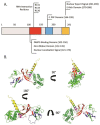Shiftless, a Critical Piece of the Innate Immune Response to Viral Infection
- PMID: 35746809
- PMCID: PMC9230503
- DOI: 10.3390/v14061338
Shiftless, a Critical Piece of the Innate Immune Response to Viral Infection
Abstract
Since its initial characterization in 2016, the interferon stimulated gene Shiftless (SHFL) has proven to be a critical piece of the innate immune response to viral infection. SHFL expression stringently restricts the replication of multiple DNA, RNA, and retroviruses with an extraordinary diversity of mechanisms that differ from one virus to the next. These inhibitory strategies include the negative regulation of viral RNA stability, translation, and even the manipulation of RNA granule formation during viral infection. Even more surprisingly, SHFL is the first human protein found to directly inhibit the activity of the -1 programmed ribosomal frameshift, a translation recoding strategy utilized across nearly all domains of life and several human viruses. Recent literature has shown that SHFL expression also significantly impacts viral pathogenesis in mouse models, highlighting its in vivo efficacy. To help reconcile the many mechanisms by which SHFL restricts viral replication, we provide here a comprehensive review of this complex ISG, its influence over viral RNA fate, and the implications of its functions on the virus-host arms race for control of the cell.
Keywords: C19ORF66; FLJ11286; IRAV; ISG; RNA granules; RNA stability; RyDEN; SVA-1; innate immune response; ribosomal frameshift; shiftless; translation.
Conflict of interest statement
The authors declare no conflict of interest.
Figures


Similar articles
-
Shiftless Restricts Viral Gene Expression and Influences RNA Granule Formation during Kaposi's Sarcoma-Associated Herpesvirus Lytic Replication.J Virol. 2022 Nov 23;96(22):e0146922. doi: 10.1128/jvi.01469-22. Epub 2022 Nov 3. J Virol. 2022. PMID: 36326276 Free PMC article.
-
IRAV (FLJ11286), an Interferon-Stimulated Gene with Antiviral Activity against Dengue Virus, Interacts with MOV10.J Virol. 2017 Feb 14;91(5):e01606-16. doi: 10.1128/JVI.01606-16. Print 2017 Mar 1. J Virol. 2017. PMID: 27974568 Free PMC article.
-
Modulation of Viral Programmed Ribosomal Frameshifting and Stop Codon Readthrough by the Host Restriction Factor Shiftless.Viruses. 2021 Jun 25;13(7):1230. doi: 10.3390/v13071230. Viruses. 2021. PMID: 34202160 Free PMC article.
-
Restriction of Flaviviruses by an Interferon-Stimulated Gene SHFL/C19orf66.Int J Mol Sci. 2022 Oct 20;23(20):12619. doi: 10.3390/ijms232012619. Int J Mol Sci. 2022. PMID: 36293480 Free PMC article. Review.
-
All About the RNA: Interferon-Stimulated Genes That Interfere With Viral RNA Processes.Front Immunol. 2020 Dec 9;11:605024. doi: 10.3389/fimmu.2020.605024. eCollection 2020. Front Immunol. 2020. PMID: 33362792 Free PMC article. Review.
Cited by
-
The Inhibition of Gag-Pol Expression by the Restriction Factor Shiftless Is Dispensable for the Restriction of HIV-1 Infection.Viruses. 2024 Apr 10;16(4):583. doi: 10.3390/v16040583. Viruses. 2024. PMID: 38675925 Free PMC article.
-
Comparative Analysis of HMC3 and C20 Microglial Cell Lines Reveals Differential Myeloid Characteristics and Responses to Immune Stimuli.Immunology. 2025 May;175(1):84-102. doi: 10.1111/imm.13900. Epub 2025 Feb 17. Immunology. 2025. PMID: 39961658 Free PMC article. Review.
-
Interferon-Stimulated Genes that Target Retrovirus Translation.Viruses. 2024 Jun 8;16(6):933. doi: 10.3390/v16060933. Viruses. 2024. PMID: 38932225 Free PMC article. Review.
-
The Interactions between Cells and Viruses.Int J Mol Sci. 2024 Jun 23;25(13):6886. doi: 10.3390/ijms25136886. Int J Mol Sci. 2024. PMID: 38999995 Free PMC article.
-
Functional features of a novel interferon-stimulated gene SHFL: a comprehensive review.Front Microbiol. 2023 Dec 11;14:1323231. doi: 10.3389/fmicb.2023.1323231. eCollection 2023. Front Microbiol. 2023. PMID: 38149274 Free PMC article. Review.
References
-
- Gaucher D., Therrien R., Kettaf N., Angermann B.R., Boucher G., Filali-Mouhim A., Moser J.M., Mehta R.S., Drake D.R., III, Castro E., et al. Yellow fever vaccine induces integrated multilineage and polyfunctional immune responses. J. Exp. Med. 2008;205:3119–3131. doi: 10.1084/jem.20082292. - DOI - PMC - PubMed
-
- Kash J.C., Mühlberger E., Carter V., Grosch M., Perwitasari O., Proll S.C., Thomas M.J., Weber F., Klenk H.-D., Katze M.G. Global suppression of the host antiviral response by Ebola-and Marburgviruses: Increased antagonism of the type I interferon response is associated with enhanced virulence. J. Virol. 2006;80:3009–3020. doi: 10.1128/JVI.80.6.3009-3020.2006. - DOI - PMC - PubMed
Publication types
MeSH terms
Substances
Grants and funding
LinkOut - more resources
Full Text Sources
Medical

